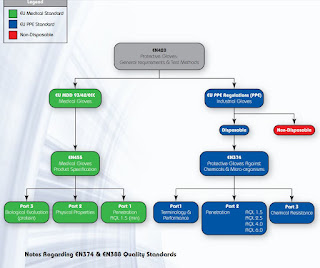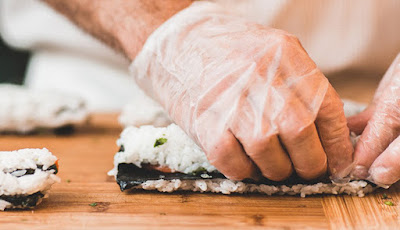Disposable gloves buying guide
Disposable Gloves
Disposable gloves are, under EU Health and Safety rules, officially an article of Personal Protective Equipment (PPE)and as such there is a duty on both the Management and users of gloves to carry out due diligence to ensure
the safety of the glove user.”
The enclosed information is provided to help you assess and determine what type of glove and
glove material would best suit your requirements.
Within this guide we have not attempted to determine which glove you should choose as there are
too many variables to be considered which means that each department will need to assess the
environment in which they work, the procedures being carried out and the materials to be used and
tested.
Disposable Gloves Types
General Purpose Gloves:Usually made from a form of plastic.
Loose fitting.
Ambidextrous - fit either hand.
Ideal in situations where a user is just wanting to stop hands from getting soiled (dirty).
Medical Examination Gloves:
In Europe, examination gloves are manufactured to either EU PPE Standards or European Medical
Devices directive product standards.
Ambidextrous - fit either hand.
Fit the hand for maximum comfort security and sensitivity.
Can have a beaded cuff to help as an aid to donning and removing and also as a extra barrier security at
the wrist.
Available either powdered or powder free.
Available either ‘Sterile’ or ‘Non-Sterile’.
Procedural/Surgical/Surgeons:
Are a high quality product giving maximum security and fit.
Are hand specific - fit either left or right hand, are sized in half sizes from 5.0 to 9.5 and are usually
packed in pairs if sterile and boxes of gloves split left and right if non-sterile.
Note: All surgical/surgeons gloves are sterile.
Are the best at providing protection but are also the most expensive disposable gloves produced.
Are used for specialist procedures where maximum barrier protection and/or high levels of dexterity are
required.
Disposable Glove Risk Assessment
Risk of Procedure/Task Glove Material
Please Note:
1) Double Donning: Extra protection can be gained through the technique of double donning two disposable
gloves, where one glove is worn over another.
2) In using gloves, the use of non-disposable gloves should not be ruled out where risk is considered too
great for disposable gloves to be worn. In such cases, a loss of sensitivity and dexterity will occur.
Glove Materials Explained
Disposable gloves are made from a variety of different materials, all designed to fulfill a specific purpose
or purposes:
Co-Polymer (Plastic):
Advantages: They are cheap in price.
Fine for simple protection to keep hands clean.
Disadvantages: Offer little practical protection.
Very loose fitting and very smooth - makes handling
implements and carrying out tasks/procedures difficult.
Latex - Natural Rubber Latex (NRL):
Advantages: Effective barrier against most substances including
blood-borne pathogens.
The material is very thin allowing a high degree of
sensitivity.
The material is very strong and flexible.
The material’s molecular structure reduces the incidence
of pinholing or tearing when carrying out procedures/
tasks.
As the material comes from a natural renewable source
(rubber trees) it is ‘environmentally friendly’.
The material is cost effective.
Disadvantages: Residual soluble proteins in NRL can cause allergic
reactions in some glove users.
As a natural material NRL is not generally a good
barrier against chemicals.
Nitrile:
Advantages: Nitrile contains no residual protein and is a good alternative to
latex for glove wearers who are allergic to the soluble proteins
in latex.
An effective barrier against most substances including blood-borne
pathogens.
Is in general a better barrier against chemicals than NRL.
Disadvantages: It is not as flexible as latex, which can cause hand fatigue in glove
users who need to wear glove for long periods of time.
It is more expensive than latex but is still a cost effective barrier
material.
Vinyl:
Advantages: A cost-effective alternative to latex for glove wearers
who are allergic to soluble proteins or residual chemicals
in NRL gloves (low risk procedures only).
Disadvantages: Not a good barrier material against blood-borne pathogens
or chemicals.
Vinyl is more susceptible to pin holing then either latex or Nitrile.
Vinyl material is more ‘friable’ and can degenerate whilst being
worn when in contact with rough surfaces on instruments or items
being handled in the procedure or task.
Vinyl material can cause hand fatigue when worn for long periods
of time.
Low Risk - Where disposable gloves
are worn to keep hands clean or
reduce contact between the wearer
and item(s) handled.
Co-Polymer
Vinyl
Synthetic
Latex
Industrial PPE - “minimal risk”
or
EU EN455 medical standard.
Medium Risk - Where gloves are
being worn as task is deemed to
pose a medium risk i.e. staining
to the hand, minor chemical burns,
allergic reactions or cross contamination
between user and test subject.
Vinyl
Latex
Nitrile
Industrial PPE - “Class I”
or
EU EN455 medical standard watertight test value <AQL 1.5.
High Risk - Where gloves are worn
as the potential of serious health
issues through exposure to biohazard or chemicals are likely.
Latex
Nitrile
Specialist i.e Neoprene
Industrial PPE - “Class III”
or
EU EN455 medical standard
watertight test value <AQL 0.65
with high force at break value of >9 Newtons.
Glove Users Well Being
Gloves, correctly used, can provide the ideal protection against a wide range of potentially hazardous
substances and are an essential part of the PPE requirments of many institutions and businesses.
It is essential however, that the glove user takes the correct precautions both before and after the use
of gloves to ensure damge to the skin through prolonged use of gloves is prevented.
To ensure the well-being of the glove user, it is important to consider the following:
Pre-Donning Procedure:
Wash your hands - are there adequate hand washing facilities available?
Hand Lotions/Barrier Creams to protect the skin - Ensure any hand lotions/barrier creams
do not contain Coconut Oil, Jojoba, Lanolin, Palm Oil, Vasaline/Petroleum Jelly or any other
petroleum based product as these can damage the barrier properties of certain gloves.
Post-Donning Procedure:
Are there adequate glove disposal facilities available?
Are there adequate hand washing facilities available?
Does the glove user require post use hand creams or lotions?
Glove Storage and Barrier Protection
Even the best gloves can fail to perform correctly if you do not adhere to good user practice!
You should store disposable gloves away from direct sunlight and excessive heat. Never place gloves
on a window ledge or on a shelf above a radiator. If you are storing gloves on racking, consider the
temperature at ceiling height. Never store gloves at temperatures exceeding 40oC.
Glove boxes should not be left open in direct sunlight or near flourescent light sources as this will
accellerate the ageing process.
You should not wear hand creams or lotions containing any of the following materials or the barrier
integrity may be affected: Coconut Oil, Jojoba, Lanolin, Palm Oil, Vaseline/Petrolium Jelly or any other
petrolium based product.
Note: Water or glycerine based lotions or creams will not compromise the glove barrier.
You should not wear rings or jewellery with projections whilst wearing disposable gloves as such
items can puncture the glove barrier.
Sharp or long fingernails can puncture the glove barrier, check that your fingernails are rounded and
smooth before donning a glove.






disposable nitrile exam gloves
ReplyDelete